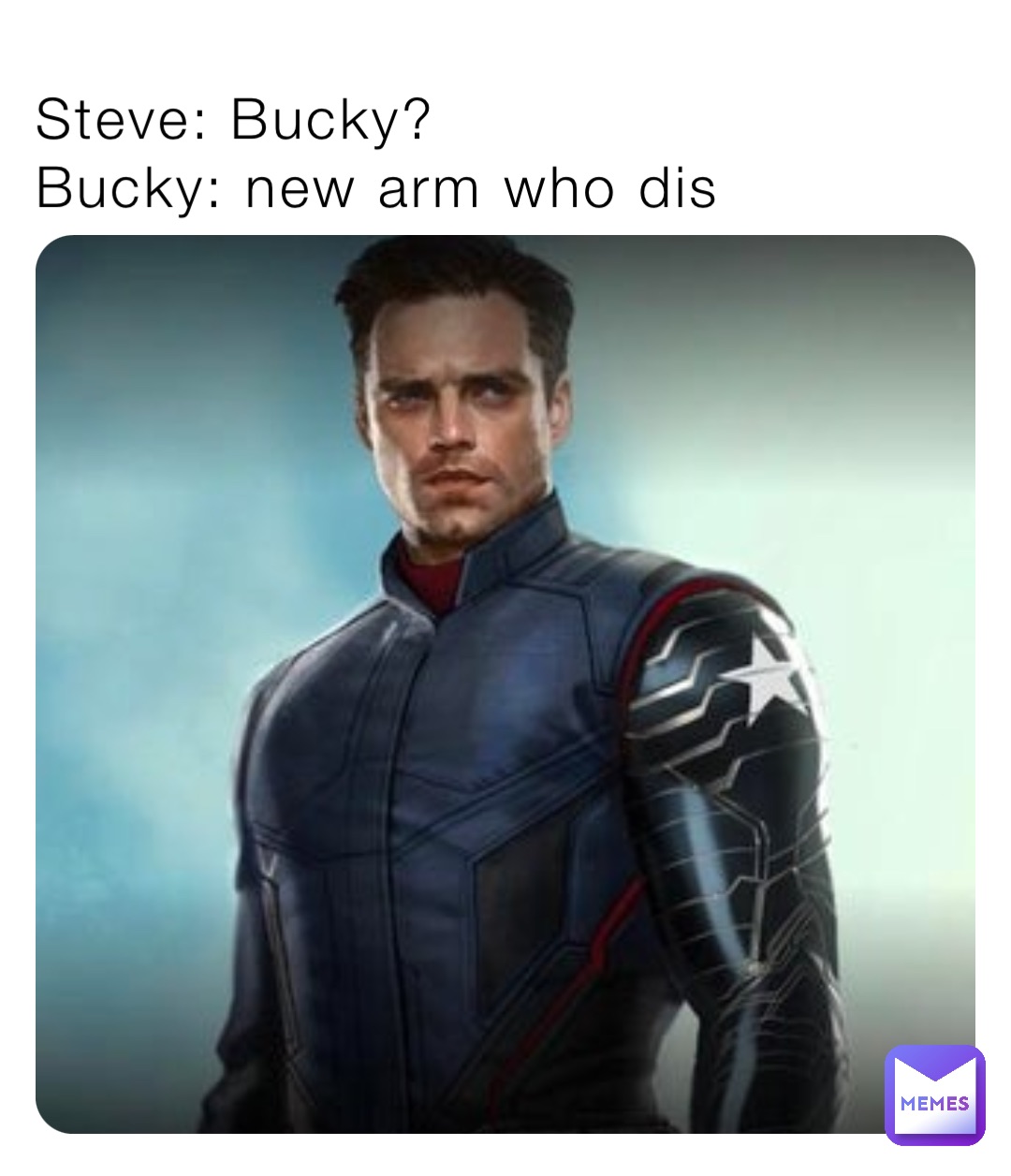Bucky's New Arm: The Cutting-Edge Prosthetic Revolutionizing Lives
Bucky's new arm has captured the imagination of millions around the world, symbolizing the incredible advancements in prosthetic technology. This groundbreaking development represents a significant leap forward in medical science and engineering. Bucky's journey from a character with a metal arm to a state-of-the-art prosthetic highlights the rapid evolution of prosthetic limbs in both fiction and reality.
In recent years, the concept of advanced prosthetics has moved from the realm of science fiction to practical reality. Bucky's new arm is not just a fictional marvel but an inspiration for real-world innovations. Engineers and scientists are working tirelessly to create prosthetic limbs that replicate natural movement and sensation, transforming the lives of amputees worldwide.
This article delves deep into the world of prosthetic technology, exploring its history, current advancements, and future possibilities inspired by Bucky's new arm. Whether you're a fan of the character or someone interested in medical technology, this comprehensive guide will provide valuable insights into the fascinating world of modern prosthetics.
Read also:All Lebron James Sneakers The Ultimate Guide For Collectors And Enthusiasts
Table of Contents
- Background of Bucky's New Arm
- The Technology Behind Bucky's Arm
- A Brief History of Prosthetics
- Current Advancements in Prosthetic Technology
- Materials Used in Modern Prosthetics
- Real-World Applications of Advanced Prosthetics
- Challenges in Developing Prosthetic Limbs
- The Future of Prosthetic Technology
- Impact on Quality of Life
- Conclusion: Embracing the Future of Prosthetics
Background of Bucky's New Arm
From Fiction to Inspiration
Bucky's new arm is a fictional yet highly influential piece of technology introduced in the Marvel Comics universe. As a character who has undergone significant transformations, Bucky Barnes' journey from a World War II soldier to the Winter Soldier is filled with challenges and triumphs. His prosthetic arm is a symbol of resilience and adaptation, inspiring countless fans and engineers alike.
While Bucky's new arm exists in a fictional world, it serves as a catalyst for discussions about real-world prosthetics. The character's experiences highlight the importance of creating prosthetic limbs that are not only functional but also integrate seamlessly with the user's body and mind.
The concept of a "smart" prosthetic arm, capable of replicating natural movements and providing sensory feedback, is no longer a distant dream. Advances in robotics, artificial intelligence, and materials science are making such innovations a reality, thanks in part to the inspiration drawn from fictional characters like Bucky.
The Technology Behind Bucky's Arm
Integration of Robotics and AI
Bucky's new arm represents the pinnacle of prosthetic technology, incorporating cutting-edge robotics and artificial intelligence. The arm is designed to mimic natural movements, utilizing advanced sensors and microprocessors to interpret the user's intentions and respond accordingly.
- Neural Interfaces: The arm is equipped with neural interfaces that allow direct communication between the user's brain and the prosthetic limb.
- Sensory Feedback: Advanced sensors provide tactile feedback, enabling the user to "feel" objects and surfaces, enhancing the sense of touch.
- Adaptive Learning: The arm uses AI algorithms to learn and adapt to the user's unique movements, improving functionality over time.
These technological advancements not only enhance the functionality of prosthetic limbs but also improve the overall quality of life for amputees. The integration of robotics and AI in prosthetics is a testament to human ingenuity and the relentless pursuit of innovation.
Read also:Who Is Bill Burrs Father Discovering The Life And Legacy
A Brief History of Prosthetics
From Ancient Times to Modern Day
The history of prosthetics dates back thousands of years, with early civilizations creating rudimentary devices to replace missing limbs. Ancient Egyptians, for example, used wooden and leather prosthetics to restore mobility to amputees. Over time, advancements in materials and engineering led to more sophisticated designs.
In the 20th century, the development of lightweight materials such as carbon fiber and titanium revolutionized prosthetic technology. The introduction of microprocessors and sensors in the late 20th century further enhanced the functionality of prosthetic limbs, paving the way for modern innovations.
Bucky's new arm is a product of centuries of technological evolution, combining historical knowledge with contemporary advancements to create a prosthetic limb that is both powerful and precise.
Current Advancements in Prosthetic Technology
Pushing the Boundaries of Innovation
Today, prosthetic technology is at the forefront of medical innovation, with researchers and engineers pushing the boundaries of what is possible. Some of the most significant advancements include:
- Myoelectric Prosthetics: These devices use electrical signals from the user's muscles to control the prosthetic limb, offering greater precision and control.
- Osseointegration: This technique involves surgically attaching the prosthetic limb directly to the user's bone, providing a more stable and comfortable fit.
- 3D Printing: The use of 3D printing technology allows for the creation of customized prosthetic limbs that are both affordable and accessible.
These advancements are making prosthetic limbs more accessible and effective, improving the lives of millions of people around the world. The continued development of prosthetic technology is a testament to human resilience and ingenuity.
Materials Used in Modern Prosthetics
Lightweight and Durable Innovations
The materials used in modern prosthetics are carefully selected to ensure durability, comfort, and functionality. Some of the most commonly used materials include:
- Carbon Fiber: Known for its strength and lightweight properties, carbon fiber is a popular choice for prosthetic limbs.
- Titanium: This metal is highly durable and resistant to corrosion, making it ideal for long-term use in prosthetics.
- Silicone: Often used for cosmetic covers, silicone provides a lifelike appearance and feel, enhancing the user's confidence and comfort.
The choice of materials plays a crucial role in the effectiveness and comfort of prosthetic limbs. Engineers and designers are constantly exploring new materials to improve the performance and aesthetics of prosthetics.
Real-World Applications of Advanced Prosthetics
Transforming Lives Through Technology
Advanced prosthetics are not just limited to fictional characters like Bucky. In the real world, these devices are transforming the lives of amputees, providing them with newfound independence and mobility. From athletes competing in the Paralympics to everyday individuals regaining their ability to perform daily tasks, prosthetic technology is making a significant impact.
Organizations such as the Veterans Administration and various non-profits are working to provide advanced prosthetics to those in need, ensuring that everyone has access to life-changing technology. The applications of prosthetic technology are vast, with new possibilities emerging every day.
Challenges in Developing Prosthetic Limbs
Overcoming Obstacles in Prosthetic Innovation
Despite the incredible advancements in prosthetic technology, there are still significant challenges to overcome. Some of the most pressing issues include:
- Cost: Advanced prosthetics can be prohibitively expensive, limiting access for many individuals.
- Size and Weight: Creating prosthetic limbs that are both powerful and lightweight remains a challenge for engineers.
- Power Supply: Ensuring a reliable and long-lasting power source for electronic prosthetics is an ongoing concern.
Addressing these challenges requires collaboration between scientists, engineers, and policymakers to ensure that prosthetic technology is accessible and affordable for all.
The Future of Prosthetic Technology
Innovations on the Horizon
The future of prosthetic technology is bright, with numerous innovations on the horizon. Researchers are exploring the possibilities of brain-computer interfaces, which could allow users to control prosthetic limbs with their thoughts. Additionally, advancements in materials science are leading to the development of prosthetics that are even lighter, stronger, and more lifelike.
As technology continues to evolve, the potential for prosthetic limbs to replicate natural movements and sensations will only increase. The future of prosthetics is not just about replacing lost limbs but enhancing human capabilities, opening up new possibilities for individuals around the world.
Impact on Quality of Life
Empowering Individuals Through Technology
The impact of advanced prosthetics on quality of life cannot be overstated. These devices provide amputees with the ability to perform daily tasks, pursue their passions, and live fulfilling lives. The emotional and psychological benefits of regaining independence and mobility are profound, empowering individuals to overcome challenges and achieve their goals.
Through the inspiration drawn from fictional characters like Bucky and the dedication of researchers and engineers, prosthetic technology is making a tangible difference in the lives of millions. The continued development of these technologies will ensure that everyone has access to the tools they need to thrive.
Conclusion: Embracing the Future of Prosthetics
In conclusion, Bucky's new arm represents a significant milestone in the evolution of prosthetic technology. From its fictional origins to its real-world applications, the concept of advanced prosthetics continues to inspire and transform lives. The integration of robotics, artificial intelligence, and cutting-edge materials is revolutionizing the field, offering hope and possibilities for amputees worldwide.
We invite you to share your thoughts and experiences in the comments below. Whether you're a fan of Bucky's story or someone interested in the future of prosthetic technology, your feedback is valuable. For more insightful articles on medical advancements and technology, explore our other content and stay informed about the latest developments in the field.


